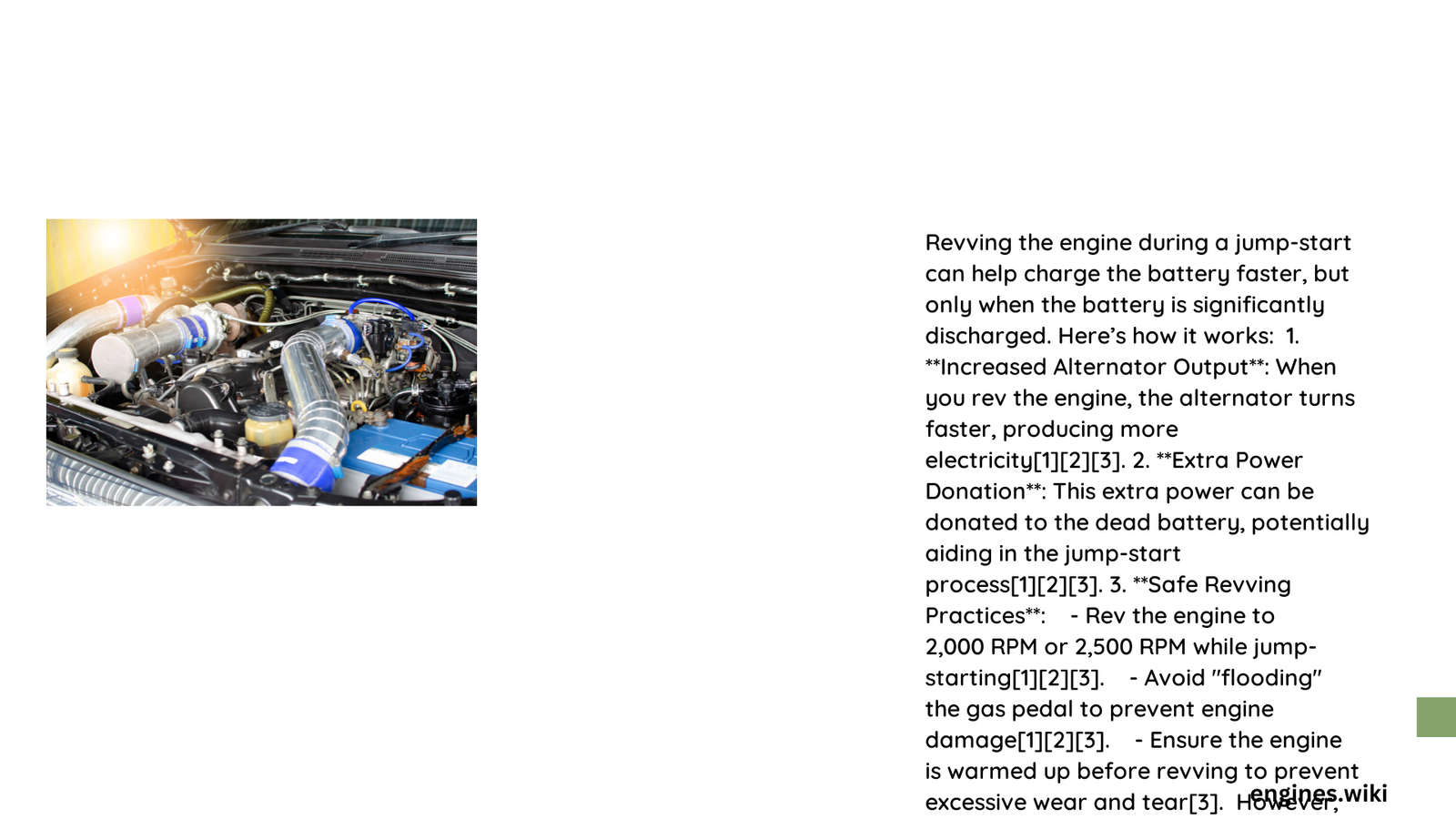When your car battery dies, jump-starting becomes a critical rescue technique. Many drivers wonder whether revving the engine can enhance the battery charging process. This comprehensive guide explores the science behind engine revving during jump-starts, revealing nuanced insights into voltage output, alternator performance, and potential risks associated with this common roadside practice.\n\n## What Happens When You Rev Engine During Jump Start?\n\nRevving an engine during a jump-start can provide marginal benefits to battery recovery. The primary mechanism involves increasing alternator output through higher RPM, which potentially supplies additional electrical current to the discharged battery.\n\n### How Does Alternator Performance Change with Engine RPM?\n\n| RPM Range | Alternator Output | Charging Effectiveness |\n|———–|——————|————————|\n| 1,200-1,500 | Low Moderate | Minimal Charging |\n| 1,500-2,500 | Optimal | Most Effective |\n| 2,500-3,000 | Diminishing Returns | Potential System Stress |\n\n#### Key Factors Influencing Jump-Start Success\n\n1. Voltage Regulation\n – Modern vehicles have regulated alternators\n – Maintains consistent 12-15 volt range\n – Minimal voltage fluctuation during revving\n\n2. Amperage Considerations\n – Higher RPM increases electrical current\n – Typical alternator capacities: 70-100 amperes\n – Slight improvement in battery charging potential\n\n### Can Excessive Revving Damage Electrical Systems?\n\nExcessive engine revving poses potential risks to vehicle electrical components:\n\n- Increased stress on alternator\n- Potential overheating of electrical systems\n- Unnecessary wear on battery connections\n- Risk of damaging sensitive electronic modules\n\n## Recommended Jump-Start Practices\n\n### What Are Safe Engine RPM Levels?\n\nExperts recommend maintaining engine speed between 1,200-2,500 RPM during jump-starts. This range provides optimal alternator performance without risking system overload.\n\n#### Step-by-Step Jump-Start Protocol\n\n1. Connect jumper cables correctly\n2. Start donor vehicle\n3. Gently increase engine speed to 2,000 RPM\n4. Maintain steady RPM for 3-5 minutes\n5. Attempt to start disabled vehicle\n6. Keep engines running for additional charging\n\n### Why Driving Remains Superior to Revving?\n\nWhile revving provides minimal benefits, driving the vehicle offers more comprehensive battery recovery:\n\n- Consistent alternator output\n- Gradual, stable battery recharging\n- Reduced risk of electrical system stress\n- Recommended duration: 20-30 minutes of continuous driving\n\n## Technical Insights\n\nModern vehicle electrical systems are designed with sophisticated voltage regulation mechanisms. The marginal improvements from revving are often negligible compared to proper charging techniques.\n\n### When Should You Avoid Revving?\n\n- Battery shows signs of significant deterioration\n- Electrical system appears unstable\n- Extreme temperature conditions\n- Presence of visible battery damage\n\n## Conclusion\n\nRevving an engine during jump-starts offers minimal benefits. While potentially providing slight amperage increases, the practice should be approached cautiously. Prioritize proper jump-start techniques and follow manufacturer recommendations for optimal vehicle recovery.\n\n### References:\n\n1. Pocono Record – Jump-Start Techniques\n2. Car Talk – Battery Recovery Methods\n3. Popular Mechanics – Electrical System Insights

